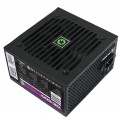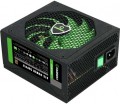Fan size
The diameter of the fan(s) in the power supply cooling system.
The large diameter allows to achieve good efficiency at relatively low RPMs, which in turn reduces noise and power consumption. On the other hand, large fans are more expensive than small ones and take up a lot of space, which affects the dimensions of the entire PSU. We also emphasize that a small fan is not yet a sign of a cheap power supply — quite advanced models can also have such equipment, in order to reduce dimensions.
As for specific diameters, the smallest value that can be found in modern consumer-grade PSUs is
80 mm. The most popular option is
120 mm, this size gives good efficiency and a relatively low noise level at a reasonable price and dimensions. Larger diameters are somewhat less common —
135 mm and
140 mm.
ATX12V version
A standard for power supplies that supplements the ATX specifications regarding power supply along the 12 V line. Introduced into use since the time of the Intel Pentium 4 processor. In the first series of the standard, the +5 V line was mainly used; from version 2.0, the +12 V line was introduced to fully power the components computer. Also in the second generation, a 24-pin power connector appeared, used in most modern motherboards.
SATA
The number of SATA power connectors provided in the PSU.
Nowadays, SATA is the standard interface for connecting internal hard drives, and it is also found in other types of drives (SSD, SSHD, etc.). Such an interface consists of a data connector connected to the motherboard, and a power connector connected to the PSU. Accordingly, in this paragraph we are talking about the number of SATA power plugs provided in the PSU. This number corresponds to the number of SATA drives that can be simultaneously powered from this model.
Cable system
The cable system used in the power supply. According to this parameter,
modular, semi-
modular and non-modular devices are distinguished, here are their features:
— Not modular. The classic version of the design, used in computer power supplies from the very beginning and not losing popularity to this day. The wires in such systems have a non-detachable design, and additional cables are not provided for connection. As a result, the user has to deal with only those cables that the manufacturer provided, without the ability to remove or replace them (the only modifications available are the installation of additional accessories such as an extension cord or splitter). Because of this, such PSUs are less convenient than modular and semi-modular ones: their wires are often excessively long, and some of them are not used at all, while such an “economy” further clutters up the case, worsening air circulation and cooling efficiency. On the other hand, these shortcomings can be reduced to almost zero with careful selection of the PSU and careful wiring; and non-modular systems themselves are distinguished by reliability and at the same time low cost. It is because of these features that they are most common nowadays.
— Modular. Systems in which each cable is made detachable; special sockets are used for fastening wires. Thanks to this design, you can optimally organize the space inside the PC —
...for example, remove unnecessary wires so that they do not interfere with air circulation in the system unit; replace a cable that is too long with a shorter wire (or vice versa); swap cables, etc. At the same time, modular systems are noticeably more expensive than non-modular ones, while they are considered somewhat less reliable due to the presence of "weak points" in the form of removable cable mounts.
— Semi-modular. A kind of compromise between the options described above: some of the wires in such power supplies are made non-removable, some are equipped with modular mounts. This makes it possible to partially combine the advantages and compensate for the disadvantages of the two systems: semi-modular PSUs are less expensive and more reliable than modular ones, and at the same time more convenient than non-modular ones. Usually, in systems of this type, the most important wires have a non-removable design, which are almost guaranteed to be used when assembling a PC, and secondary cables are equipped with removable mounts and can be removed if not needed. However, the specific features of a semi-modular PSU should be specified separately.Braided wires
The presence of a braid in the complete wires of the system unit — for all or at least for some.
This feature has a positive effect on reliability, making the wire as resistant as possible to bending, abrasion, strong pressure and other similar influences; it also provides additional protection against accidental contact with sharp objects (for example, when repairing a PC). The disadvantages of braided wires, in addition to increased cost, are also increased thickness and greater rigidity than similar cables in conventional insulation. This can create some difficulties in organizing space inside the system unit.
+3.3V
The maximum values of current and power that the PSU can provide on individual power lines.
The power line can be simply described as a pair of contacts for connecting a particular load; one of these contacts is “ground” (with zero voltage), and the second has a certain voltage with a plus or minus sign, this voltage corresponds to the voltage of the power line. In this paragraph, it is + 3.3V (such power is present in 20- and 24-pin connectors for motherboards, in SATA power connectors and some other types of connectors).
In general, power and currents are rather specific parameters that the average user rarely needs — mainly when connecting high-power components such as video cards, as well as when starting a PSU without a computer to power other electronics (for example, amateur radio stations). It is also worth mentioning that the sum of the maximum powers on all lines can be higher than the total output power of the PSU — this means that all lines cannot operate at full power at the same time. Accordingly, when the PSU is fully loaded, some of them will produce less power than the maximum possible.
+5V
The maximum current that the PSU is capable of issuing + 5V to the power line. For more information about power lines in general, see "+3.3V". Also note here that + 5V power, in addition to connectors for motherboards (for 20 and 24 pins), is also found in Molex and SATA plugs, as well as some other specific types of connectors.
+12V1
The maximum current that the PSU is capable of delivering to the first power line is + 12V.
For more information about power lines in general, see "+3.3V". Here it is worth mentioning that 12 V is the most popular voltage among computer power connectors. It is used in almost all such connectors (with a few exceptions), and some plugs (for example, additional PCI-E power for 6 or 8 connectors) use only 12-volt lines — and in the + 12V format. And the division of + 12V power into several separate lines is used for safety purposes — in order to reduce the current flowing through each individual wire, and thus prevent excessive load and overheating of the wiring. However, some manufacturers do not specify the maximum current for individual + 12V lines and give only a general value in the characteristics; in such cases, this number is indicated in this paragraph.
+12V2
The maximum current that the PSU is capable of delivering to the second power line is + 12V.
For more information about power lines in general, see "+3.3V". Here it is worth mentioning that 12 V is the most popular voltage among computer power connectors. It is used in almost all such connectors (with a few exceptions), and some plugs (for example, additional PCI-E power for 6 or 8 connectors) use only 12-volt lines — and in the + 12V format. And the division of + 12V power into several separate lines is used for safety purposes — in order to reduce the current flowing through each individual wire, and thus prevent excessive load and overheating of the wiring. However, some manufacturers do not specify the maximum current for individual + 12V lines and give only a general value in the characteristics; in such cases, this number is indicated in the paragraph "+12V1".

